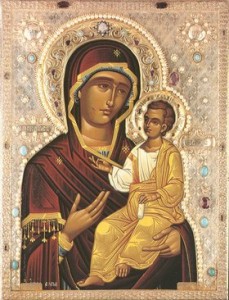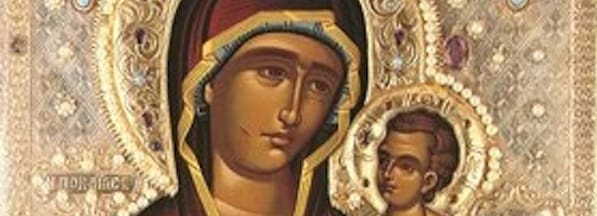Dear Father John, I am a recent “revert” to Catholicism – and I am so glad to be so! Recently, a friend of mine published a book about finding female power through sacred global feminine symbols. This involves, from her perspective, abandoning all patriarchal religious traditions. I never bought into radical feminism – in fact, in college I rebelled against what I saw as the genderless feminist movement. But parts of this book moved me deeply. So now I am wondering about the real motivations behind my Catholic reversion (maybe it was just a continuation of my old rebellion by uniting myself to a patriarchal religion?). And I am worried that I will have to defend my “archaic and powerless beliefs” to my progressive peers. How do I justify my modern self, bowing before men and needing a man to witness my confession in order to be freed of my sins? I would love to hear your take on this…
 I think there is a short answer to this question and a long answer. The short answer is that when you go to confession you are not confessing to a man because he is a man, and when you bow before Jesus, you are not bowing before a man because he is a man. If that were the case – if the Church was making you do this because it was discriminating against women – then the Church would not also require men to go to confession or to worship Jesus. But the Church does require that. In fact, it even requires men to venerate women: the Blessed Virgin Mary and the woman saints who are celebrated in the liturgy are necessarily venerated by all the faithful, including men.
I think there is a short answer to this question and a long answer. The short answer is that when you go to confession you are not confessing to a man because he is a man, and when you bow before Jesus, you are not bowing before a man because he is a man. If that were the case – if the Church was making you do this because it was discriminating against women – then the Church would not also require men to go to confession or to worship Jesus. But the Church does require that. In fact, it even requires men to venerate women: the Blessed Virgin Mary and the woman saints who are celebrated in the liturgy are necessarily venerated by all the faithful, including men.
God Is God
But getting back to God: The reason for our humble reverence towards God is because God is God. And our worship of Jesus is because Jesus is God, not because Jesus is male. Your newfound faith and reverence for God are definitely just not a subconscious rebellion against false feminism. They are a response to the grace God has given you to discover the amazing worthiness of the divine, of God’s love for you, of God’s infinitely good plan and dream for your life.
This distinction (that God is not male) is really important for us to think about, meditate on, and accept. As you allude to in your note, our culture is a bit confused and tangled when it comes to gender issues, so we have to purposely educate ourselves. This takes a lot of time, a lot of prayer, and even some study.
Equality of Men and Women
I love how the Catechism addresses this. First, it reminds us of the basic truth that is found ONLY in Christianity (it’s not even found fully in early Judaism):
(CCC #2334) “In creating men ‘male and female,’ God gives man and woman an equal personal dignity. Man is a person, man and woman equally so, since both were created in the image and likeness of the personal God.”
So, we as Catholics establish clearly that, at least as far as the teaching of Jesus and the Church, men and women are different, but share equally in human dignity. Chauvinism of any kind is, for us, a sin. Certainly, Catholics have fallen into that sin, especially because it has been so deeply ingrained in various human cultures. But when you actually look at the real history of gender relations in western culture, you discover a slow but steady improvement in gender justice under the influence of the Catholic worldview. Blessed John Paul II’s Theology of the Body is a recent and remarkable advance in this area.
God Is not Male (or Female)
But then the Catechism addresses the other issue – the issue of God being “male”. And the Church makes clear that God is not male. God is neither male or female. Male and female are human genders that together reflect the “image and likeness of God” (see Genesis 1:27) here on earth. There is a mystery here. The equal dignity but fundamental complementarity of men and women is not something we can fully grasp, like a mathematical formula. It is something we discover, experience, become fascinated with, live, and grow to understand more and more – but we will never exhaust this mystery. It is too profound, too divine, too sacred. We are called to marvel at it and to live it, and to enjoy this gift as God has meant it to be enjoyed.
Now, getting back to God not being male. Here is the paragraph from the Catechism. It is a little long, but I want you to read it all:
(#239) By calling God “Father”, the language of faith indicates two main things: that God is the first origin of everything and transcendent authority; and that he is at the same time goodness and loving care for all his children. God’s parental tenderness can also be expressed by the image of motherhood, which emphasizes God’s immanence, the intimacy between Creator and creature. The language of faith thus draws on the human experience of parents, who are in a way the first representatives of God for man. But this experience also tells us that human parents are fallible and can disfigure the face of fatherhood and motherhood. We ought, therefore, to recall that God transcends the human distinction between the sexes. He is neither man nor woman: he is God. He also transcends human fatherhood and motherhood, although he is their origin and standard: no one is father as God is Father.
This is what we believe of God. Again, it is hard to grasp completely. Our human experience always involves male and female, mother and father, husband and wife. We are bound in our language by all kinds of “hes” and “shes”. And that is as it should be. When we speak of God, our human language is limited, and we have to recognize that. Nevertheless, God has helped us by revealing himself, and he uses human language to do it – calling himself Father, and the Bridegroom of Israel, for example. And we can rest assured that God’s revelation is wise and true, and as we accept it and meditate on it, we will grow in wisdom and understanding of these truths.
What about Jesus and the Male Priesthood?
But there is another issue that critics bring up. They have a problem with the fact that God became incarnate as a male human being: Jesus is a man, not a woman. For some people, this is proof that Christianity is actually a tyrannical patriarchy and intrinsically anti-woman. And since the Catholic Church maintains an exclusively male priesthood, we Catholics are even worse in this area than the other Christian denominations. So say the critics.
But that is a very distorted way to look at Jesus and his Church. It flows from the let’s-get-beyond-gender mentality that you mention in your note. If gender is only a social invention and a tool for oppression, then we must neuter both men and women – this is the unhealthy feminism and genderism that, I think, you rightly rejected in college. From that perspective, of course, Jesus can’t really be God, and an all-male priesthood can’t really be God’s idea. But that is not our perspective.
We believe (as discussed above) that God purposely created us in two genders, and that the mysterious and wonderful complementarity of those two genders permeates – by his design – all that we are and all that we do. It is reflected in different roles that emerge in the various realms of human activity – biological complementarity is the most obvious, but there is also psychological, emotional, even spiritual complementarity. And this complementarity is reflected – naturally and necessarily – in certain social roles: men can’t be mothers; women can’t be fathers. But that doesn’t make mothers innately superior to fathers, or fathers innately superior to mothers. They are different but mutually interdependent, and complementary.
Now, if God were to call together fallen and divided humanity into a new, redeemed spiritual family, it would make sense for the profile of that family to reflect the two genders. It would make sense for a spiritual fatherhood and motherhood to be present and manifest in that spiritual family. And that’s what we have in the Catholic Church. We have Jesus as the New Adam; we have Mary as the New Eve; we have the priesthood as an extension of God’s spiritual fatherhood; we have holy women (saints, foundresses, martyrs…) as a constant manifestation of spiritual motherhood… God is very consistent. The gender complementarity that he created for the human family before original sin doesn’t disappear after the redemption. It is redeemed and present in the new People of God that is the Church.
Talking about This
A lot has been written about this – I am only scratching the surface. If you want to go deeper and reflect more, you can look at some of the resources I include at the bottom of this post. Unfortunately, when it comes to explaining this to our secular friends, it’s hard going. This is because we have different starting places. Their starting place is often an unconsciously accepted presumption that human nature is intrinsically genderless (or at least that the obvious gender distinctions in human nature are meaningless), and so gender differences are nothing more than social stigmas to be overcome. Whereas our starting place is that God, in his glorious and joyful wisdom, actually created human nature with a meaningful gender distinction, and the mysterious complementarity between the genders, reflected somehow in every act and scene of the human drama, is one of the most wonder-full traits of his amazing creation.
For further reading on this issue:
- (This one is a must read, especially parts III and IV) On the Collaboration of Men and Woman in the Church and the World, Congregation for the Doctrine of the Faith
- On the Dignity and Vocation of Women, Pope John Paul II
- On Reserving Priestly Ordination to Men Alone, Pope John Paul II
- On the Question of Admission of Women to the Ministerial Priesthood, Congregation for the Doctrine of the Faith
- “The Myth of Catholic Misogyny,” Chapter Three in The Seven Big Myths about the Catholic Church, Christopher Kaczor
+
Art for this post on reversion versus rebelling against feminism: Theotokos Iverskaya, unknown Orthodox Christian painter, 10th century, PD-US author’s life plus 100 years or less, Wikimedia Commons.





